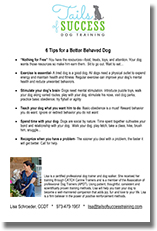Has your dog ever growled at you or someone else? If so, trust me, you’re not alone! Quite often, clients become embarrassed or angry when their dog growls; not surprising since sometimes a growl is a precursor to aggression. That being said, just like it’s unrealistic to think a person could go through life never raising their voice at others, it’s also unrealistic to expect your dog never to growl.
Most growls are a dog’s way of warning the humans or other dogs around them to stop doing something. Although it can be hard to believe, a growl is really a good thing! It’s your dog’s way of saying he’s not comfortable with whatever it is that’s occurring at that moment. Whether he’s growling at another dog, a person or something you are can’t quite identify – from your dog’s point of view, there “is” a valid reason for his warning. It’s his way of saying, “Stop! I’m not comfortable with this!”
Let’s face it, growls often take us by surprise and our response is a knee jerk reaction, not a well-thought out plan. Owner’s responses range from shouting while roughly pulling their dog away, to giving him a swat on the rump or even holding their dog’s mouth shut by wrapping their hands around his muzzle in an attempt to keep him quiet. These responses further increase the stress level of an already upset dog. Instead, recognize that a growl is a low level warning and respect your dog’s feelings by hearing him loud and clear and responding accordingly.
Here are five helpful things you can do when your dog growls:
- Acknowledge the situation. Realize your dog’s vocalization is a sign that he is uncomfortable and do something about it.
- Assess the situation. Look around and attempt to determine what caused your dog to growl. Knowing your dog’s triggers will help you avoid them in the future.
- Increase the distance between your dog and what has upset him. Sometimes, distance alone will help your dog become more comfortable.
- Be prepared to remove your dog if increasing the distance does not calm him. Don’t be tempted to make your dog endure an already uncomfortable situation which can increase stress and exacerbate unwanted behavior.
- Work to change your dog’s feelings about the thing that caused the growl. For example, if your dog has not spent much time around small children and he growls at the neighbor’s child (which can be scary for everyone), recognize the socialization deficit and get to work. Instead of your dog thinking “child = bad thing!” you want them to think “child = good thing!” Use a training technique called counter conditioning and desensitization to slowly and consistently accomplish this over time. If you feel you’re over your head, call in the help of a dog trainer.
And a final note of caution: Never, ever punish your dog for growling. Punishment might make the dog stop growling, but the underlying emotional stress is not gone. If you use punishment, you’re merely taking away the “warning signal”, which is your dog’s way of saying, “I’m uncomfortable!” and the next time he may may go straight to a higher level warning, like a bite.
Next time your dog growls, pause, stay calm, thank him for letting you know how he is feeling and help him to feel more safe, calm and happy!


